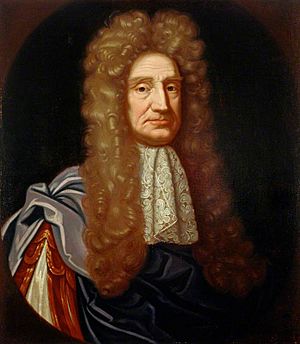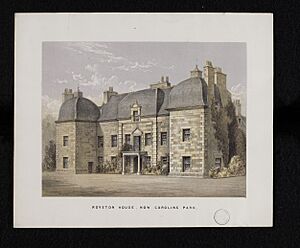George Mackenzie, 1st Earl of Cromartie facts for kids
Quick facts for kids
The Earl of Cromartie
|
|
|---|---|

The 1st Earl of Cromartie
|
|
| Secretary of Scotland | |
| In office 21 November 1702 – 17 October 1704 |
|
| Monarch | Queen Anne |
| Preceded by | The Duke of Queensberry |
| Succeeded by | The Earl of Roxburghe |
| Personal details | |
| Born | 1630 Innerteil, Fife, Scotland |
| Died | 17 August 1714 (aged 84) Tarbat House, Ross-shire, Scotland |
| Alma mater | University of St Andrews University of Aberdeen |
George Mackenzie, the 1st Earl of Cromartie (born 1630, died 1714), was an important Scottish statesman. He was also known as Sir George Mackenzie, 2nd Baronet, and later as The Viscount of Tarbat. He played a key role in Scottish politics during the late 1600s and early 1700s.
Contents
The Life of George Mackenzie
Early Years and Education
George Mackenzie was born in 1630 in Innerteil, a place near Kinghorn in Fife, Scotland. He was the oldest son of Sir John Mackenzie of Tarbat. His family had strong connections to the powerful Mackenzie clan. His mother was Margaret, the daughter of Sir George Erskine, a judge.
George went to St Andrews University and King's College, Aberdeen. He finished his studies in 1646. He became very good at classical studies and was interested in books and science. However, his main passion was politics.
Joining the Royalist Cause
In 1653, George Mackenzie joined an uprising led by Glencairn. This uprising supported Charles II, who was trying to regain his throne. After a defeat in 1654, George had to flee to Eilean Donan castle.
When his father passed away in 1654, George inherited the family lands. He then escaped to Europe and lived in exile for some time. During this period, he spent a lot of time studying law.
Return to Power
When Charles II became king again in 1660, George Mackenzie returned to Scotland. His old commander, Middleton, was now in charge of Scottish affairs, and George became his main advisor.
In 1661, George was made a judge, known as Lord Tarbat. He also became a member of the Scottish Parliament for Ross-shire. He helped create a law that cancelled all previous laws made since 1640. This was done to help bring back the system of bishops in the church (episcopacy).
Political Challenges
George Mackenzie and Middleton faced opposition from John Maitland, 1st Duke of Lauderdale, who was the Minister for Scottish Affairs. They tried to remove Lauderdale from his position.
In 1662, they came up with a plan called the "act of billeting." This plan involved a secret vote in Parliament to declare certain people unable to hold public office. Lauderdale was one of the people they wanted to remove. However, the king did not agree with the vote and kept it secret.
Later, it was discovered that Middleton had misled both the king and Parliament. As a result, Middleton was removed from his job. George Mackenzie was also punished for his part in the plan and lost his position as a judge in 1664.
Regaining Influence
George Mackenzie remained out of favour until 1678. Thanks to the help of Archbishop Sharp and the Duke and Duchess of Lauderdale, he was appointed Lord Justice General of Scotland. This was a very important legal role.
The next day, King Charles II gave him a pension of £200. Soon after, he became a member of the Privy Council of Scotland. This council advised the king. The king also officially pardoned him for his earlier involvement in the "act of billeting."
In 1681, he became Lord Clerk Register, which meant he was in charge of official records. He also became a judge again.
Chief Minister and Viscount
When Lauderdale lost power in 1682, George Mackenzie became the king's main minister in Scotland. He held this important role until the Glorious Revolution.
After James II became king, George Mackenzie was given a new title in 1685. He became the Viscount of Tarbat and Lord Macleod and Castlehaven.
In 1683, he bought land north of Edinburgh and built a house called Royston House. This house was later renamed Caroline Park.
Adapting to Change
When it became clear that King James II would lose his throne, George Mackenzie tried to ensure his own safety and keep his position. He advised the council to disband the militia, which helped the new government take power peacefully.
In 1689, he was officially cleared of any wrongdoing from his time as register. This meant he was safe from any legal problems related to his past actions.
After the Battle of Killiecrankie in 1689, the government asked him to negotiate with the Highland clans. He understood Highland politics very well, and his advice helped bring peace. Some historians believe that if his plan to pay the Highland chiefs had been followed earlier, it could have prevented more conflict.
In 1692, he was given back his job as clerk register. However, he resigned from this role in 1695.
Earl of Cromartie and the Union
When Queen Anne came to the throne, George Mackenzie was appointed one of the Secretaries of State in 1702. In 1703, he was given the title of Earl of Cromartie. He was also chosen to represent Scotland in the British Parliament.
In 1704, he resigned as Secretary of State. In 1705, he became Lord Justice General again, holding this position until 1710.
One of his most important achievements was his strong support for the union of Scotland and England. He believed that joining the two countries into one kingdom was the best path forward. His efforts for the Union are considered a major part of his legacy as a statesman.
George Mackenzie passed away on August 17, 1714, at New Tarbat. He was buried in Dingwall, Scotland.
Family Life
George Mackenzie had four sons with his first wife, Anna Sinclair. Their sons were Roderick (who died young), John (who inherited his father's titles), Kenneth, and James. James had a daughter who later married and became Lady Anne Dick. James himself later adopted the title Lord Royston.
George Mackenzie did not have any children with his second wife, Margaret, Countess of Wemyss.
His Writings and Interests
George Mackenzie was interested in many things beyond politics. He was involved in setting up the Royal Society of London, a famous scientific group. He wrote several papers for their 'Transactions,' including observations on natural history in Scotland and accounts of severe weather.
He also wrote about the islands of Hirta and Rona in the Hebrides. He published many political pamphlets, which were short books or essays about political topics. Some of his notable political writings include:
- 'Parainesis Pacinca. or a Persuasive to the Union of Britain' (1702), where he argued strongly for Scotland and England to become one country.
- 'A Few Brief and Modest Reflections persuading a Just Indulgence to be granted to the Episcopal Clergy and People of Scotland' (1703), discussing religious tolerance.
- 'Trialogues: A Conference between Mr. Con, Mr. Pro, &c, concerning the Union' (1706), which was a discussion about the Union.
Besides politics, he wrote historical works:
- 'A Vindication of King Robert III from the Imputation of Bastardy' (1695), defending the legitimacy of a Scottish king.
- 'Historical Account of the Conspiracy of the Earl of Gowrie and of Robert Logan of Restalrig against James VI' (1713), about a historical plot.
He also wrote a book called 'Synopsis Apocalyptica' (1707), where he tried to explain prophecies from the Bible.
A letter he wrote to the famous scientist Robert Boyle is included in a book called The Secret Commonwealth by Robert Kirk.


